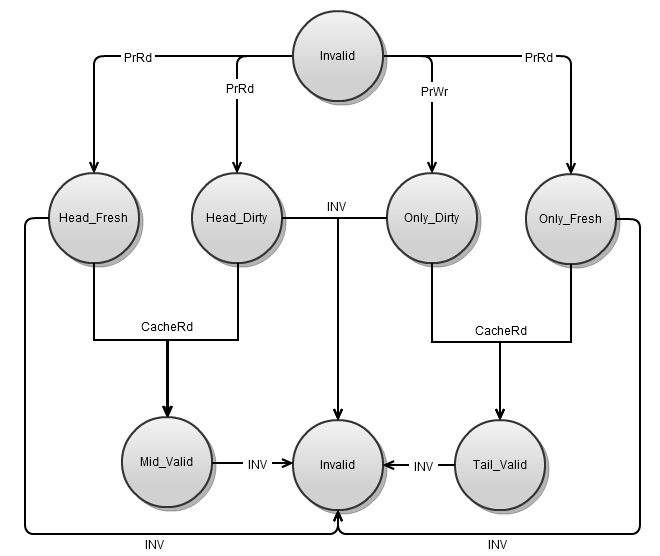Scalable Coherent Interface: Difference between revisions
(→General Operation: adding information on linked list and cache line) |
m (→Linked List) |
||
| Line 10: | Line 10: | ||
==Linked List== | ==Linked List== | ||
Each cache that holds a given block is a member of that block's linked list. When a new cache requests a block, the memory supplies the id of the '''Head cache'''. Each cache in the list contains a link to the previous cache and the next cache in the list. In this way, the list is distributed. | Each cache that holds a given block is a member of that block's linked list. When a new cache requests a block, the memory supplies the id of the '''Head cache'''. Each cache in the list contains a link to the previous cache and the next cache in the list. The last cache in the list is the '''Tail cache'''. In this way, the list is distributed. | ||
Because SCI is an invalidation protocol, the linked list is cleared upon every write. First, the writing cache adds itself to the head of the list, then indicates to the next cache that it is invalidating the block. | Because SCI is an invalidation protocol, the linked list is cleared upon every write. First, the writing cache adds itself to the head of the list, then indicates to the next cache that it is invalidating the block. | ||
==Cache Lines== | ==Cache Lines== | ||
Revision as of 19:00, 15 April 2011
SCI is an IEEE standard for shared-memory multiprocessing. The standard was approved in 1992. View the SCI Wikipedia article for more information on the interface's history. The article covers the cache-coherence portions of the IEEE standard.
General Operation
Cache coherence in SCI uses several main components to ensure reliability.
Memory Directory
SCI operates by using directories in every processor's memory. When a memory block has not been cached, the directory holds this block in the Home state, signifying that the block is at home. After a read request, the memory holds this block in the Fresh state and will supply the data immediately to any requesting cache. After a write request, the memory holds the block in the Gone state. The memory does not supply the data to further requesting caches, but instead supplies the cache with a link to a cache that holds this data.
The directory can be expected to take up to 4% of the total memory space.
Linked List
Each cache that holds a given block is a member of that block's linked list. When a new cache requests a block, the memory supplies the id of the Head cache. Each cache in the list contains a link to the previous cache and the next cache in the list. The last cache in the list is the Tail cache. In this way, the list is distributed.
Because SCI is an invalidation protocol, the linked list is cleared upon every write. First, the writing cache adds itself to the head of the list, then indicates to the next cache that it is invalidating the block.
Cache Lines
Besides the data for the linked list, each cache line needs to store the standard cache information (i.e. tag). This information is expected to be about 7% of the total cache memory.
Cache State Machine
The caches states cover two different dimensions: the cache's position in a linked list, and the modified state of a block.
- Head - The first, but not only member of the list.
- Mid - Neither the first nor last member of the list.
- Tail - The last member, but not only member of the list.
- Only - The only member of the list.
- Clean - The data is unmodified, and only I have it.
- Modified - The data is modified.
- Fresh - The data is unmodified, and I and and others have it.
- Valid - My copy of the data is valid, but others have it as well.
- Invalid - I do not have a valid copy of the data.
The possible combinations of these two attributes are shown in the state diagram below.
Directory State Machine
Each cache block's directory can be in one of three states. These states designate whether the block is cached, and whether the cached block is dirty.
- Home - The block is not cached. It is at "home".
- Gone
- The block is cached by at least one cache, and the cached value is probably dirty.
- When a cache requests the block, the memory will supply an identifier for the first cache in the list.
- Fresh
- The block is cached by at least one cache, but the cached value is not dirty.
- The memory will supply the data upon cache requests.
Race Conditions
References
- Wikipedia, Scalable Coherent Interface
- SCI
